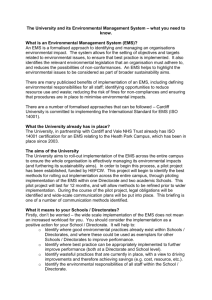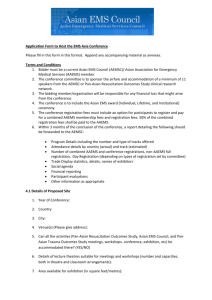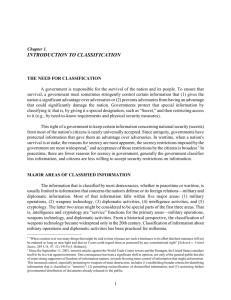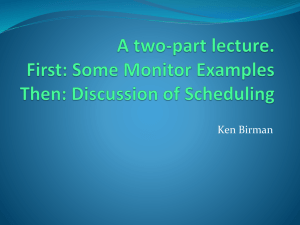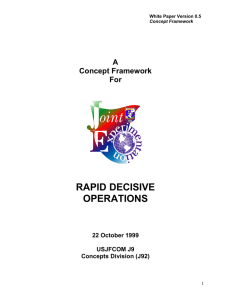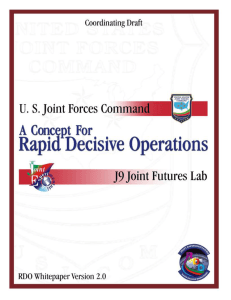Focus Areas
advertisement
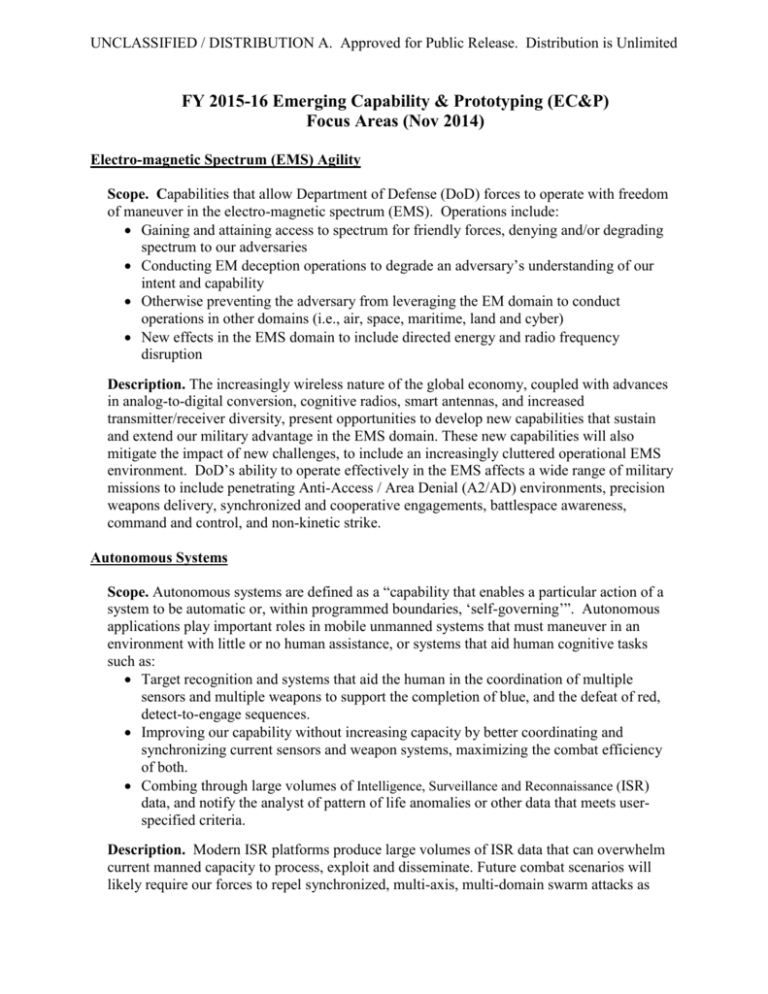
UNCLASSIFIED / DISTRIBUTION A. Approved for Public Release. Distribution is Unlimited FY 2015-16 Emerging Capability & Prototyping (EC&P) Focus Areas (Nov 2014) Electro-magnetic Spectrum (EMS) Agility Scope. Capabilities that allow Department of Defense (DoD) forces to operate with freedom of maneuver in the electro-magnetic spectrum (EMS). Operations include: Gaining and attaining access to spectrum for friendly forces, denying and/or degrading spectrum to our adversaries Conducting EM deception operations to degrade an adversary’s understanding of our intent and capability Otherwise preventing the adversary from leveraging the EM domain to conduct operations in other domains (i.e., air, space, maritime, land and cyber) New effects in the EMS domain to include directed energy and radio frequency disruption Description. The increasingly wireless nature of the global economy, coupled with advances in analog-to-digital conversion, cognitive radios, smart antennas, and increased transmitter/receiver diversity, present opportunities to develop new capabilities that sustain and extend our military advantage in the EMS domain. These new capabilities will also mitigate the impact of new challenges, to include an increasingly cluttered operational EMS environment. DoD’s ability to operate effectively in the EMS affects a wide range of military missions to include penetrating Anti-Access / Area Denial (A2/AD) environments, precision weapons delivery, synchronized and cooperative engagements, battlespace awareness, command and control, and non-kinetic strike. Autonomous Systems Scope. Autonomous systems are defined as a “capability that enables a particular action of a system to be automatic or, within programmed boundaries, ‘self-governing’”. Autonomous applications play important roles in mobile unmanned systems that must maneuver in an environment with little or no human assistance, or systems that aid human cognitive tasks such as: Target recognition and systems that aid the human in the coordination of multiple sensors and multiple weapons to support the completion of blue, and the defeat of red, detect-to-engage sequences. Improving our capability without increasing capacity by better coordinating and synchronizing current sensors and weapon systems, maximizing the combat efficiency of both. Combing through large volumes of Intelligence, Surveillance and Reconnaissance (ISR) data, and notify the analyst of pattern of life anomalies or other data that meets userspecified criteria. Description. Modern ISR platforms produce large volumes of ISR data that can overwhelm current manned capacity to process, exploit and disseminate. Future combat scenarios will likely require our forces to repel synchronized, multi-axis, multi-domain swarm attacks as UNCLASSIFIED / DISTRIBUTION A. Approved for Public Release. Distribution is Unlimited well as apply distributed, synchronized mass to penetrate enemy defenses. Repelling synchronized attacks will require us to coordinate a diverse array of sensors and weapons in a time window that challenges human cognition. Sophisticated adversary defenses, such as Integrated Air Defense Systems (IADS), can be penetrated using coordinated and synchronized mass attacks. We will likely need to operate unmanned systems in EMSdegraded environments where the human decision-maker’s situational awareness and span of battlespace control will be degraded. Space Capability Resilience Scope. Space Capability Resilience responds to a sophisticated adversary’s attempts to deny us access to our space-based capabilities and adverse space conditions that degrade our spacebased capabilities. A resilient response includes: Taking proactive and reactive defensive measures (Avoidance), Designing systems with enhanced survivability features (Robustness), Conducting operations to replenish lost or diminished capacity (Reconstitution) and Help re-establish space capability and capacity (Recovery). Subsystems and activities that support any systems architecture able to achieve effects normally associated with current space systems. Description. Assure that military and related intelligence functions perform at the level necessary to execute assigned mission with an acceptable tolerance for risk. Capabilities focus on the military functions dominantly provided by space systems; consider both maintaining and replenishing capabilities, and balances risk-based functional performance, resilience, and affordability. Activities likely will be degraded in a space-contested environment include: Missile warning, Position, Navigation and Timing (PNT) information, space-enabled communications, space situational awareness, and ISR. Asymmetric Force Application Scope. Asymmetric Force Application includes the use of non-traditional technologies, tactics, and weapons to provide a clear military advantage to our forces during maneuver and engagement operations. Solutions will reduce U.S. reliance on overleveraged blue capabilities and creatively exploit increasingly capable adversary systems while adjusting the cost curve in our favor. Applications of particular interest are those able to provide an innovative technology offset and/or cost calculus advantage. Description. U.S. power projection capabilities must keep pace with emerging threats. Technologies are needed to counter threats associated with integrated air defense systems, long range penetrating strike, and offensive and defensive air superiority operations. 2






